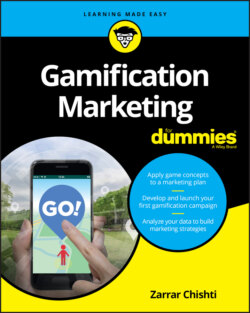Читать книгу Gamification Marketing For Dummies - Zarrar Chishti - Страница 27
User experience
ОглавлениеThe user experience game type involves designing your campaign around the psychology of your intended audience. You can go further and consider their behaviors, thought processes, and capabilities as well.
I like to think of user experience as creative design elements that create a unique and long-lasting impression on your player. The ultimate goal here is data collection (see Chapter 10). You gather data is by tapping into the behaviors and thought processes your intended audience will respond positively to.
Before I look into the various specifics of user experience elements, let me offer some tips on user experience in general:
Learn as much as you can about your intended audience (see Chapter 9). This is the best advice I can offer to my clients. For instance, if you’re thinking your audience is men from 18 to 30 years old, go back to your research because that’s too vague. There are so many types of players with different tastes and expectations when it comes to the complexity of the game. You can’t appeal to them all. So, it’s best to be more specific and design the campaign for those who will most likely engage positively.
Less is more. When you’re looking to add elements to your game, you may be tempted to add as many elements as you can. This impulse is natural. As a marketer, you want to add extra mechanics to ensure maximum engagement. But using fewer elements is the core of the user experience discipline.
Your campaign’s gamification user experience should feel seamless. This is harder to achieve than it may sound. When designing your game, make sure to prevent any discontinuity in the user experience. You want the gameplay to be compelling and the feedback to be instantaneous in order to keep the campaign flowing. An example of this is to employ the same level of responsiveness in every element you design. Anything that the player interacts with should respond with visual and audio cues.
As with any marketing campaign, try to keep your user experience consistent. Create a user experience bible that contains the core principles of your user experience. Then make sure all designers and developers adhere to this bible. Consistency helps your audience find their way around the gamification campaign more easily because they’ll have fewer rules to figure out and remember.
To gather as much behavioral and personal information as possible on your campaign’s audience, along with the relative objective data, you have to use an analytics program (see Chapter 11). The data you collect will allow you to spot issues with your campaign’s user experience design very clearly.
Here are some elements of the user experience game type (not every user experience game will have every one of these elements, so you can pick and choose what works for you):
Badges and achievements: Gamification badges and achievements are a recognition of the commitment that your audience makes to your campaign. Using them appropriately will motivate players to work through all your challenges and actively promote your campaign to others. The prospect of earning more badges is one of the best audience engagement tools. Use badges wisely and in a meaningful way to make them more appreciated by your audience. For instance, make your audience earn each badge instead of just giving it to them for simply registering their details. But don’t make it too hard and rare for the audience to earn a badge either.
Leaderboards: Leaderboards are a useful element to increase engagement in your campaign. They’re commonly used to show your audience how they compare to others and so others can see how they’re faring. In its simplest form, a leaderboard is a high-score listing. It’s the visual representation of a real-time competition within your campaign. Leaderboards encourage your audiences to compete and set goals for themselves. Finally, leaderboards allow players to keep track of their progress in relation to the other players.
Experience points: Just like badges, experience points are feedback elements. You can use them to allow your audience to track progress and as a way to unlock new elements within the campaign. Experience points should be based on the audience’s achievement within the campaign. In your campaign, players should earn experience points by doing tasks and completing objectives.
Skill or chance: This element promotes the idea that your audience has a good chance to win something within your campaign. Skill and chance are deeply rooted in game design. They’re a way for players to win rewards with very little effort.
Easter eggs: An Easter egg is a hidden feature, level, or bonus that your audience wouldn’t normally encounter while playing. They can only be found by searching levels and exploring your campaign. Easter eggs are a fun way to reward and surprise your audience just for engaging with your campaign. They encourage audiences to spend more time interacting with your campaign. The harder Easter eggs are to find, the more exciting and viral your campaign will become.
